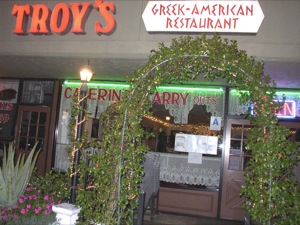dining out
Epicurious Eating: Troy’s Greek Restaurant
Olympian lemon rush
Published Thursday, 10-Dec-2009 in issue 1146
Hidden within the confluence of strip plazas where Friars Road merges into Mission Gorge Road is the meekly outdated Troy’s Greek Restaurant. As indicated by homely carpeting, rattan chairs and plaster-cast corbels sprouting fake vines, the family-owned operation has been around since 1985, lending credence to an array of mainstream Greek specialties that drum steady traffic.
Far more flavorful than the food at Daphne’s — the burgeoning café chain better known for its “fire feta” burgers than its limply spiced gyros and kabobs – though not quite as captivating as what I remember of the garlicky fare at Aesop’s Tables in La Jolla (now closed), the meals at Troy’s can nonetheless leave you with some palatable memories.
Visiting as a foursome to celebrate a birthday, we started with saganaki, flaming Kasseri cheese that our guest of honor upholds as tradition whenever he “goes Greek.” While the dish varies little from one Greek restaurant to another, depending on how much brandy, oil and lemon douse the young sheep’s milk cheese, I was impressed by its volume. There was enough gooey substance on the hotplate to go around twice. Soft triangular-cut pita bread served alongside for scooping the curds was duly utilized, despite tasting generically commercial.
Tzatziki sauce, however, was in short supply and we had to keep asking for more little plastic cups of the stuff throughout our meal. Much to our liking, it’s spiked with a touch of dill, which in lieu of traditional mint equally compliments the cucumber-garlic yogurt admixture. In a perfect world, the sauce would be served at tables in large bowls – something I’ve yet to witness in North American Greek establishments.
Supplementing our appetizer course was a plate of five falafel balls served with olives and more pita. They were moist with crunchy exteriors and we could actually detect cumin and coriander in the mix and perhaps undertones of clove. They were a cut above the sawdust matter made oftentimes days ahead in other kitchens using aged, dried chickpeas.
Lemon began playing a dynamic role in subsequent dishes, starting with customary chicken-rice soup (avgolemono). Unlike so many other versions, this wasn’t too starchy or eggy. In shortcut recipes lemon juice is thrown into the soup toward the end of the cooking process, resulting in a harsh, last-minute citrus blast. Here, it became apparent that the lemon was added directly into the base, a froth of whipped eggs that is incorporated methodically into the broth. The result is a refreshing, streamlined tang that is both subtle and pervasive. Why the amount of chicken in three bowls that we ordered varied so dramatically remains in question.
Incredibly juicy Greek-style half chicken and thick wedges of roasted potatoes served with a few of our entrees were also lemon-kissed, though not just superficially. The citrus essence seeped seemingly into every atom of flesh while allowing the host flavors to subsist. The only problem was that most of the spuds were hard and dry in the middle, either because they were slightly undercooked or sat hours in a low-heat oven before exiting the kitchen.
Pastitsio is one of my favorite Hellenic dishes, but only when the crowning layer of béchamel isn’t equal or greater in width than the dense under layer of spiced ground beef and macaroni. Such was the case, as I found myself scraping off scads of the white sauce at every forkful. Only after it was removed did the classic flavors of cinnamon, mint and nutmeg arise from the meat.
Our birthday boy opted for the gyro-spanakopita combo plate and expressed satisfaction over the meal’s abundance, noting that the gyro meat in particular was above average in terms of savor and moistness. Another in our party chose the beef souvlaki platter featuring two long skewers of charbroiled meat marinated thoroughly in oil, lemon and herbs. For that I was in reaching distance, although I struck out with a tedious piece of meat harboring tendons. Apparently there were a few more like it in the lineup, according to comments from the others.
If you’re a stranger to Greek wine, ask for samples before ordering. We tasted two and passed on both, a Naoussa Amethystos blend of cab and merlot, and a grand reserve of the same label. One was too prune-y and the other was sour. Greece is supposedly the oldest wine-producing country on the globe, but to date I’ve never met a varietal that leaves me aching for more.
We were disappointed that the restaurant didn’t comp our friend’s birthday baklava, especially given that it skimped on phyllo pastry and contained too much nut filling, which was dry and crumbly. The transposed Caledonian recipes are far better, I find.
In addition to a large dining room loaded with tables and booths, Troy’s offers outdoor seating on a patio that would be appealing if it weren’t sitting at the jaws of a parking lot. Otherwise, the experience offers bodily comfort and straightforward Greek fare that has withstood bad economies and a location not immediately visible from the road.
|
| |||||||||||||||||||||||||||
Copyright © 2003-2025 Uptown Publications


